

Good Running Form for Beginners. For any runner to achieve the best race results, running efficiently—relaxed and with good form—is required.
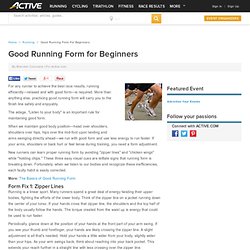
More than anything else, practicing good running form will carry you to the finish line safely and enjoyably. The adage, "Listen to your body" is an important rule for maintaining good form. When we maintain good body position—head over shoulders, shoulders over hips, hips over the mid-foot upon landing and arms swinging directly ahead—we run with good form and use less energy to run faster. If your arms, shoulders or back hurt or feel tense during training, you need a form adjustment. New runners can learn proper running form by avoiding "zipper lines" and "chicken wings" while "holding chips. " How Beginning Runners Can Improve Endurance Without Injury. After gaining confidence from crossing the finish lines of their first few 5Ks or 10Ks, many runners who are new to the sport try to improve their race times.
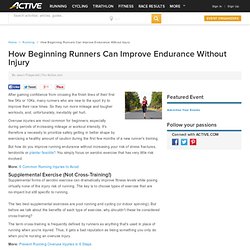
So they run more mileage and tougher workouts, and, unfortunately, inevitably get hurt. Overuse injuries are most common for beginners, especially during periods of increasing mileage or workout intensity. It's therefore a necessity to prioritize safely getting in better shape by exercising a healthy amount of caution during the first few months of a new runner's training.
But how do you improve running endurance without increasing your risk of stress fractures, tendonitis or plantar fasciitis? You simply focus on aerobic exercise that has very little risk involved. The Couch-to-5K ® Running Plan. By Josh ClarkPosted Saturday, 1 January, 2011 Couch to 5K ® | Beginning Running First off, you may be asking, "exactly how many miles is a 5K?
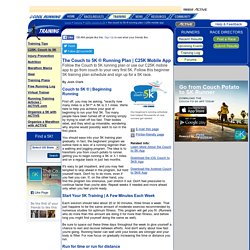
" A 5K is 3.1 miles. Stay Loose: Stretches for Runners. By Josh ClarkPosted Sunday, 31 March, 2002 There's an endless number of runners who seem perfectly able to squeeze in many hours of running every week but who just don't seem to have the time to stretch for five or ten minutes before and after.

Find the time. Sure, it's not as fun as hitting the road, and the benefits may not be as immediately obvious. Is Barefoot Running the "Perfect Running Shoe"? It is estimated that over 75 percent of shod runners are rear-foot strikers (landing heel first).

Prevent Running Overuse Injuries in 6 Steps. To improve as a runner, regardless of your ability and experience, you need to run consistently over long periods of time.

But logging miles regularly—some at quicker paces to prepare for races—can result in overuse injuries. Outsmart injury with this six-step process: Learn your body Develop efficient patterns of movement Improve joint mobility Strength train Identify training errors Increase your body awareness Learn Your Body When runners and triathletes visit Erik Taylor, a National Academy of Sports Medicine certified trainer in Redondo Beach, California, the first thing he does is analyze their strengths and weaknesses. "There are deviations in biomechanics and these will lead to injuries," Taylor says.
More: Improve Your Form If you've suffered from the same recurring injury, or experience soreness, tightness or aches in the same places frequently, visit a trained specialist, sports medicine doctor or physical therapist for a biomechanical analysis. Barefoot Running Tips for Beginners. The barefoot and minimalist running movement is becoming more popular as people try to shed their shoes.

If you're curious about experimenting with barefoot running, use these five tips for a healthy and safe transition. 1. Keep your mileage low. A common issue with those starting out is what is referred to "top of foot pain" (TOFP), which occurs when you do much more than your feet are able to handle. Your feet have been supported by shoes all your life, so it is unrealistic to go out and run six miles without that support. Try just walking barefoot around the house for a day and see how you feel the next day. 2. 5 Core Exercises That Increase Stability and Running Efficiency. Running Form: Midfoot Strikers vs. the Balls of Your Feet. There seems to be quite a debate going as to which way of running is best, with a midfoot strike or running on the balls of your feet.
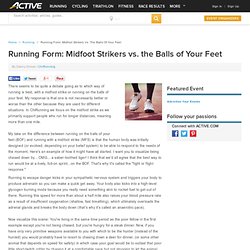
My response is that one is not necessarily better or worse than the other because they are used for different situations. In ChiRunning we focus on the midfoot strike as we primarily support people who run for longer distances, meaning more than one mile. Become the Runner You Want to Be in 2013: March. Part 2 of this series explored the vital role proper nutrition plays in your running performance.
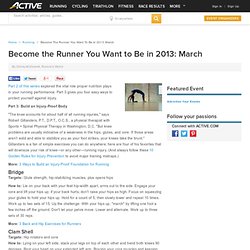
Part 3 gives you four easy ways to protect yourself against injury. Part 3: Build an Injury-Proof Body "The knee accounts for about half of all running injuries," says Robert Gillanders, P.T., D.P.T., O.C.S., a physical therapist with Sports + Spinal Physical Therapy in Washington, D.C. "But knee problems are usually indicative of a weakness in the hips, glutes, and core. If those areas aren't solid and able to stabilize you as your foot strikes, your knees take the brunt. " Build Core Strength and Endurance Without Crunches. Why You Don't Need Crunches 1 of 18 Crunches activate very few muscles.
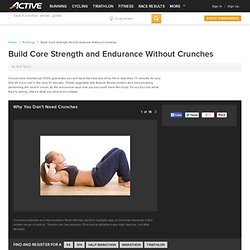
Most athletes perform multiple reps of crunches because of the limited range of motion. Therein lies the problem: Endurance athletes have high stamina, but little strength. 4 Strength Exercises for Time-Strapped Runners. Prevent Running Injuries for Life. As an orthopaedic sports medicine surgeon, I am fortunate to treat athletes of many skill levels across many disciplines. Unfortunately, the nature of my practice means I regularly see patients struggling with broken dreams and changed race plans as a result of an injury. In fact, I was one of these individuals in 2012. I can speak as a physician and an athlete because my 2012 season was derailed by a femoral stress fracture. My plans of competing in the Boston Marathon and Ironman Lake Placid were cancelled because of preventable mistakes.
Fortunately, most overuse injuries can be avoided by following a few simple guidelines. The best injury treatment is prevention. How to Execute a Run/Walk Program Properly. Ideal for brand-new runners, or those returning to the sport from injury or a long layoff, a run/walk program guides the athlete to a safe transition from non-running to running, or allows him or her to return to running successfully. Before beginning this run/walk training plan, note the following: Good Running Form for Beginners.